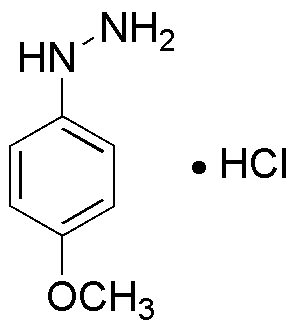4-Methoxyphenylhydrazine hydrochloride is widely utilized in research focused on:
- Synthesis of Pharmaceuticals: This compound serves as an intermediate in the synthesis of various pharmaceutical agents, particularly in the development of anti-cancer drugs, enhancing the efficiency of drug discovery.
- Analytical Chemistry: It is employed in analytical methods for detecting and quantifying certain compounds, providing researchers with reliable data for quality control in laboratories.
- Biochemical Research: Used in the study of hydrazone formation, it aids in understanding enzyme mechanisms and metabolic pathways, which is crucial for biochemists and molecular biologists.
- Material Science: The compound finds applications in the development of polymers and resins, contributing to innovations in materials with specific properties for industrial use.
- Food Industry: It is utilized in the detection of certain food contaminants, ensuring food safety and compliance with health regulations, which is vital for food manufacturers.
General Information
Properties
Safety and Regulations
Applications
4-Methoxyphenylhydrazine hydrochloride is widely utilized in research focused on:
- Synthesis of Pharmaceuticals: This compound serves as an intermediate in the synthesis of various pharmaceutical agents, particularly in the development of anti-cancer drugs, enhancing the efficiency of drug discovery.
- Analytical Chemistry: It is employed in analytical methods for detecting and quantifying certain compounds, providing researchers with reliable data for quality control in laboratories.
- Biochemical Research: Used in the study of hydrazone formation, it aids in understanding enzyme mechanisms and metabolic pathways, which is crucial for biochemists and molecular biologists.
- Material Science: The compound finds applications in the development of polymers and resins, contributing to innovations in materials with specific properties for industrial use.
- Food Industry: It is utilized in the detection of certain food contaminants, ensuring food safety and compliance with health regulations, which is vital for food manufacturers.
Documents
Safety Data Sheets (SDS)
The SDS provides comprehensive safety information on handling, storage, and disposal of the product.
Product Specification (PS)
The PS provides a comprehensive breakdown of the product’s properties, including chemical composition, physical state, purity, and storage requirements. It also details acceptable quality ranges and the product's intended applications.
Certificates of Analysis (COA)
Search for Certificates of Analysis (COA) by entering the products Lot Number. Lot and Batch Numbers can be found on a product’s label following the words ‘Lot’ or ‘Batch’.
*Catalog Number
*Lot Number
Certificates Of Origin (COO)
This COO confirms the country where the product was manufactured, and also details the materials and components used in it and whether it is derived from natural, synthetic, or other specific sources. This certificate may be required for customs, trade, and regulatory compliance.
*Catalog Number
*Lot Number
Safety Data Sheets (SDS)
The SDS provides comprehensive safety information on handling, storage, and disposal of the product.
DownloadProduct Specification (PS)
The PS provides a comprehensive breakdown of the product’s properties, including chemical composition, physical state, purity, and storage requirements. It also details acceptable quality ranges and the product's intended applications.
DownloadCertificates of Analysis (COA)
Search for Certificates of Analysis (COA) by entering the products Lot Number. Lot and Batch Numbers can be found on a product’s label following the words ‘Lot’ or ‘Batch’.
*Catalog Number
*Lot Number
Certificates Of Origin (COO)
This COO confirms the country where the product was manufactured, and also details the materials and components used in it and whether it is derived from natural, synthetic, or other specific sources. This certificate may be required for customs, trade, and regulatory compliance.


